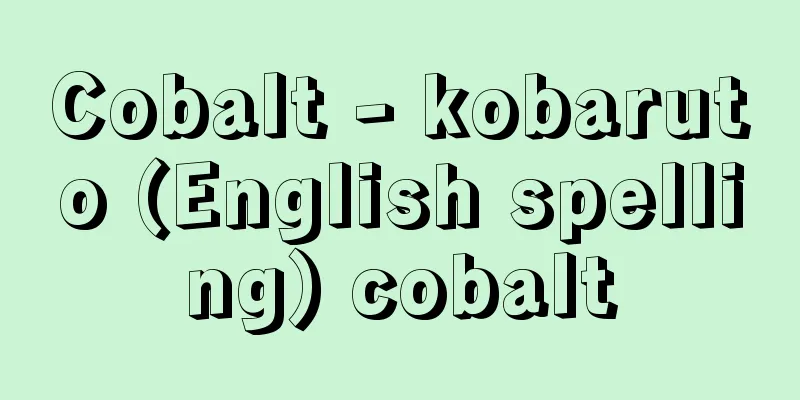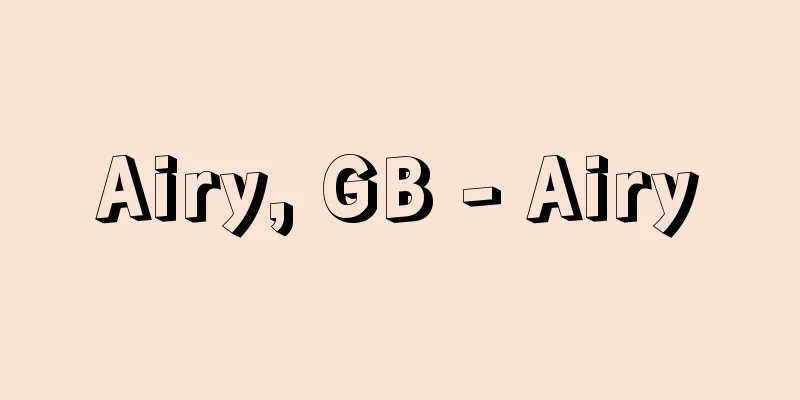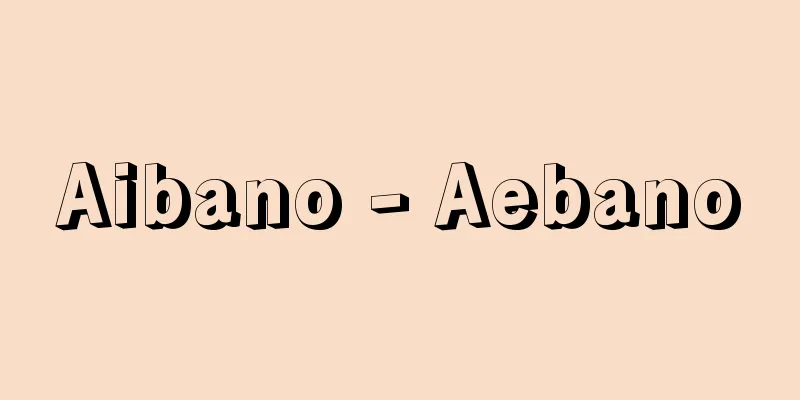Cobalt - kobaruto (English spelling) cobalt

|
It is a member of the iron group and belongs to the 9th group of the periodic table. Cobalt ores were used in ancient Egypt and China to paint glass and ceramics blue. Because the presence of these ores made it difficult to refine metals, cobalt was named after the Greek mountain god Kobolos, who was said to have been mischievous and caused trouble for humans. [Torii Yasuo] ExistenceIn 1735, the Swede Georg Brandt (1694-1768) succeeded in extracting the element from its ore, and since then the element itself has been called cobalt. Cobalt is widely distributed in the lithosphere as arsenide, sulfide, and oxide ores, most of which are associated with other metals such as nickel and copper. Major examples include smaltite CoAs 2 , cobaltite CoAsS, cobaltite 3CoO・As 2 O 5・8H 2 O, and gosudo. On the other hand, many ores of nickel, copper, and lead contain small amounts of cobalt, which is more important as an industrial resource. Iron meteorites also contain about 0.6% of cobalt in a free state. Also, very small amounts are found in the livers of animals as a component of vitamin B12 . [Torii Yasuo] Manufacturing methodMethods for extracting metallic cobalt vary depending on the nature of the raw ore, but generally, selected ore is first melted in an electric furnace to concentrate the metallic components in the form of slag, arsenic or alloys, and then dissolved in concentrated sulfuric acid. Other coexisting metallic components are separated by appropriate chemical treatment and precipitated as cobalt hydroxide, which is then heated to about 800°C to produce cobalt oxide ( Co2O3 ) . Granular cobalt is obtained by reducing this with charcoal at about 1000°C, or it can be reduced with hydrogen at about 700°C to produce powder. Cobalt can also be recovered by electrolyzing the solution with a lead anode instead of the chemical process. In either case, the purity is 99% or higher. Cobalt of higher purity can be obtained by electrolytic reduction of a cobalt(III) sulfate solution or by thermal decomposition of cobalt carbonyl. Another method is to convert it to chloropentamminecobalt(III) chloride [CoCl(NH 3 ) 5 ]Cl 2 and then thermally decompose it. [Torii Yasuo] natureIt is a silvery-white metal that looks similar to iron and nickel. It has two crystal modifications: α (alpha) (hexagonal close-packed) and β (beta) (cubic close-packed). At room temperature, the α form is more stable, but it changes to the β form above 417°C. However, because the energy difference between the two forms is small, not all of the atomic layers return to the hexagonal form upon cooling, and some of the cubic form remains. Such disruption of the packing layers can also occur due to plastic deformation. Both modifications are ferromagnetic, but it becomes paramagnetic at 1,121°C. It has ductility similar to iron and nickel, but its viscosity is greater than that of wrought iron, and its hardness and rigidity are greater than those of steel. Chemical stability varies depending on the state. Fine powder produced by hydrogen reduction is structurally a beta form, but when heated in air it catches fire and burns, and impure forms spontaneously. In contrast, granular form does not change significantly even if left in air at room temperature for a long time, except for the formation of an oxide film. When heated, it oxidizes, and when incandescent it burns and produces tricobalt tetroxide (Co 3 O 4 ) . It is less soluble in hydrochloric acid and dilute sulfuric acid than iron. It dissolves well in dilute nitric acid, but does not dissolve in concentrated nitric acid because it is passive like iron. It is insoluble in caustic alkali like iron and nickel, but when ammonia is present (especially when air or an oxidizing agent is present), it forms a complex salt and dissolves. Cobalt forms many compounds in the oxidation states II and III. Cobalt(III) in particular is famous for forming many stable complex salts (mostly 6-coordinated), and much of the basic research in complex salt chemistry is conducted on this type of compound. [Torii Yasuo] ApplicationsPure metals are used, for example, as catalysts for the Fischer-Tropsch synthesis, but their more important use is as components of various alloys. They are used in the manufacture of ultra-hard materials for cutting tools, such as high-speed steels and sintered carbide alloys, and in magnetic materials, such as KS steel and molybdenum-cobalt steel. Various superalloys have also been developed that have excellent oxidation resistance, corrosion resistance, and wear resistance at high temperatures, and non-ferrous alloys containing 25-65% cobalt are one such example. When metallic cobalt is irradiated with neutrons in a nuclear reactor, it is possible to artificially create the radioactive isotope cobalt-60, which has a half-life of 5.2 years. The gamma rays it emits are powerful and inexpensive, so it is used in a wide range of fields, including radiation chemistry research, physics, chemistry, engineering, and biology, as well as in place of radium as a gamma ray source. Gamma rays are used to irradiate genetics and other research, and are known as gamma farms. They can also penetrate deep into the human body, so they are used to treat tumors. [Torii Yasuo] The human body contains about 2 milligrams of cobalt, mainly as a component of vitamin B12 . Vitamin B12 is an antianemic vitamin, and cobalt deficiency causes pernicious anemia due to vitamin B12 deficiency. Excessive cobalt can cause nausea, rashes, and hearing loss. [Tomomi Kono and Yonago Yamaguchi] "Encyclopedia of Minerals" edited by Yoshinori Itokawa (2003, Asakura Publishing) [References] | [Supplementary Materials] |©Shogakukan "> Periodic Table Source: Shogakukan Encyclopedia Nipponica About Encyclopedia Nipponica Information | Legend |
|
周期表第9族に属し、鉄族元素の一つ。コバルトの鉱石は古代からエジプトや中国でガラスや陶磁器を青く彩色するのに用いられていた。これらの鉱石が存在すると金属の精錬が困難であったので、いたずら好きで人間を困らせたと伝えられるギリシアの山神コボロスKobolosにちなんでコバルトとよばれていた。 [鳥居泰男] 存在1735年、スウェーデンのブラントGeorg Brandt(1694―1768)が鉱石から元素を単体として取り出すことに成功し、以来、元素そのものがコバルトとよばれるようになった。 コバルトは砒(ひ)化鉱、硫化鉱、酸化鉱として岩石圏に広く分布しているが、そのほとんどがニッケル、銅などの他の金属を伴っている。おもなものとしてスマルタイトCoAs2、コバルタイトCoAsS、コバルト華3CoO・As2O5・8H2O、呉須土(ごすど)などがあげられる。一方、ニッケル、銅、鉛などの鉱石で少量のコバルトを含んでいるものも多く、工業資源としてはむしろこのほうが重要である。隕鉄(いんてつ)の中にも遊離状態で平均0.6%程度存在する。また、きわめて微量ではあるが動物の肝臓中にビタミンB12の成分として含まれる。 [鳥居泰男] 製法金属コバルトの抽出法は原鉱の性質によって多様であるが、一般には、まず精選した鉱石を電気炉で融解処理して金属成分を鈹(かわ)、砒鈹または合金の形で濃縮し、濃硫酸などに溶かす。適当な化学処理で共存する他の金属成分を分離して水酸化コバルトとして沈殿させ、約800℃に加熱して酸化コバルトCo2O3とする。これを約1000℃で木炭で還元すると粒状コバルトが得られる。また、約700℃で水素還元すると粉状となる。化学的工程のかわりに溶液を鉛陽極で電解してコバルトを回収する方法も行われている。いずれによっても純度は99%以上である。より高純度のコバルトは、硫酸コバルト(Ⅲ)溶液の電解還元、コバルトカルボニルの熱分解などによって得られる。ほかにクロロペンタアンミンコバルト(Ⅲ)塩化物[CoCl(NH3)5]Cl2に変え、熱分解する方法も用いられる。 [鳥居泰男] 性質銀白色の金属で、見かけは鉄、ニッケルに似ている。α(アルファ)形(六方最密充填(じゅうてん))、β(ベータ)形(立方最密充填)の二つの結晶変態がある。常温ではα形のほうが安定であるが、417℃以上でβ形に変わる。しかし、両形のエネルギー差が少ないため、冷却によって全部の原子層が六方型に戻らず、部分的に立方型が残る。このような充填層の乱れは塑性変形によっても生ずる。いずれの変態も強磁性を示すが、1121℃で常磁性に変わる。鉄、ニッケル類似の展延性をもつが、粘度は錬鉄より大きく、硬さと剛性は鋼よりも大きい。 化学的安定性は状態によって異なる。水素還元法で製造した微粉状のものは、構造的にはβ形であるが、空気中で熱すると火を発して燃え、不純なものは自然発火する。これに対し粒状のものは、常温で空気中に長時間放置しても酸化物の被膜が生ずるだけで、著しい変化はおこらない。熱すると酸化が進み、白熱すれば燃えて四酸化三コバルトCo3O4を生ずる。塩酸や希硫酸には鉄よりは溶けにくい。希硝酸にはよく溶けるが、濃硝酸に対しては鉄と同様に不動態をつくるので溶けない。カ性アルカリには鉄、ニッケルと同様不溶であるが、アンモニアを含む(とくに空気や酸化剤が共存する)場合には錯塩をつくって溶ける。コバルトは酸化数ⅡおよびⅢの状態で多くの化合物をつくる。とくにコバルト(Ⅲ)は多くの安定な錯塩(多くは6配位型)をつくることで有名であり、錯塩化学の基礎的研究の多くはこの種の化合物で行われている。 [鳥居泰男] 用途純金属は、たとえばフィッシャー‐トロプシュ合成用触媒などに用いられるが、むしろ各種合金の成分としての用途のほうが重要である。高速度鋼、焼結炭化物合金などの切削工具用の超硬質材料、KS鋼、モリブデン‐コバルト鋼などの磁石材料の製造に用いられる。また、高温での耐酸化性、耐食性、耐摩耗性に優れた超耐熱合金(超合金)が種々開発されているが、コバルト25~65%を含む非鉄合金もその一つである。 原子炉中で金属コバルトに中性子を照射すると、半減期5.2年の放射性同位体コバルト60を人工的につくることができる。これが放出するγ(ガンマ)線は強力でかつ安価でもあるので、ラジウムにかわってγ線源として放射線化学の研究のほか、理化学、工学、生物学など広い分野で利用されている。γ線を照射して遺伝学などの研究を行うものを、とくにγ農場といっている。また、人体の深部まで浸透するので腫瘍(しゅよう)の治療に用いられる。 [鳥居泰男] 人体に約2ミリグラム含まれ、主としてビタミンB12の構成成分として存在する。ビタミンB12は抗貧血性ビタミンで、コバルトの欠乏症はビタミンB12欠乏症の悪性貧血である。また、過剰症には悪心(おしん)や発疹(はっしん)、聴覚障害などがある。 [河野友美・山口米子] 『糸川嘉則編『ミネラルの事典』(2003・朝倉書店)』 [参照項目] | [補完資料] |©Shogakukan"> 周期表 出典 小学館 日本大百科全書(ニッポニカ)日本大百科全書(ニッポニカ)について 情報 | 凡例 |
<<: Cobalt mineral - Cobalt mineral
>>: Kovar seal (English spelling)
Recommend
Fumae (English spelling) floor
A mining term referring to the floor of a tunnel o...
Liver fortune telling - Kanzourarunai
…The livers of various animals have been studied ...
Onodera Michitsuna - Onodera Michitsuna
...A group of warriors in the Middle Ages. The fo...
Begonia dregei (English spelling) Begoniadregei
…[Yoshiyuki Uemura]. … *Some of the terminology t...
Zaleukos (English spelling)
A lawgiver in the Greek colony of Locrii (Apoikia)...
Nuclear battery - genshiryokudenchi
A device that converts the radiation energy emitt...
Panama hat plant
A perennial plant of the family Panamansia (APG c...
Retention of ownership
In a sales contract, the seller promises to reserv...
Appendicitis - appendicitis
The end of the small intestine transitions into t...
Konjo (English spelling) Prussian blue
In general inorganic pigments, it refers to blue ...
Silver alloy
…There is also white gold, which is an alloy of s...
Bronze (English spelling)
It has two meanings. One is a copper alloy with t...
Nūḥ Abū al-Ghuṣn (English spelling)
…an Arab witticist of the early Islamic period. T...
Caramelized candy - Caramelized candy
〘Noun〙 (Karume is an abbreviation of "Carmela...
Circularly polarized light
When focusing on the vibration of either the elect...









